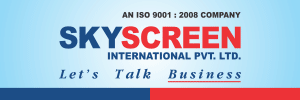
‘At the Forefront to Acquire and Adopt New Technologies’: Rajesh Kulkarni, CMD, Keetronics India (P) Ltd.
02 September 2024: Rajesh Kulkarni, CMD, Keetronics India (P) Ltd., Shares Details About Recent Developments and Products Introduced in the Industrial Screen Printing Segment.
What is the significance of the new offerings by Keetronics from a market demand or customer requirement point of view ?
At Keetronics we offer Optical Bonding services. In the present day scenario, almost every product operates with a touch switch and a touch screen. Touch screens and LCDs are mostly brought out from China. Customers wish to have these two products optically bonded along with the touch switch, which is produced on glass or PMMA.
The second product is an E-paper display. There is a demand for such products where the customer wishes to change the data very frequently and cannot provide power. For example, a price tag with all details in an electronics gadget shop.
What was the thought process behind their being created and introduced at this stage ?
Optical bonding has many advantages like sunlight readability, better viewing angle, no dust ingress and better touch. E-Paper has the advantage of changing the data on hundreds of devices in a second without moving from the desk.
How do these new offerings from Keetronics reflect upon the greater capabilities of Keetronics when it comes to industrial screen printing ?
Optical bonding needs skilled manpower; having done critical jobs in printing, our team is capable of handling this new technology. Also, the front glass with touch switches will be printed by the same team and hence it’s a value addition to our existing business. Same is the case with EPD, its purely electronics printing activity.
How would you describe the Keetronics approach towards R&D and product innovation when it comes to the industrial screen printing segment ?
We have always been at the forefront to acquire and adopt new technologies evolved in the field of screen printing. We have experience in printed electronics for the last 30 years and have a team of engineers continuously working to come up with new solutions for our esteemed customers.
What are the aspects that set these new offerings from Keetronics apart ?
The main aspect is the dependency on imports and the delivery time required to get this done are reduced. In addition, it is a saving in terms of inventory cost plus the freight and custom duty that has to be borne on the product.
What has been the initial feedback or response to these new offerings from Keetronics ?
In fact, our customers approached us and asked us to get invested in this new product range, so we expect a very good response from them.
How do you see the market for industrial screen printing and these new offerings from Keetronics going forward ?
The market for industrial screen printing is growing and getting more and more evolved every year. The use of nano technology is becoming popular and this brings an opportunity to develop high-tech products in India.
Automative Sensors Division
Embedded Techno Products …
- Premier design service provider since 1994
- Over five decades of expertise in automation, process control, sensor & actuator technologies
- Five Million units of ten products in automotive domain are on vehicles
- Legacy in partnering relationship with FFPL as their supplier partner for more than 25 years
- Large esteemed client base includes leading Filters, Genset, PV, HCV and LCV OEMs and Tier 1 automotive suppliers.
Electronic Paper Display …
E-paper display, short for electronic paper display, is a type of display technology that replicates appearance of ink on paper. Key aspects and features of e-paper displays …
- Electrophoretic Technology: E-paper typically utilizes electrophoretic technology, where tiny capsules or chambers containing positively and negatively charged particles are suspended in a clear fluid. These particles are typically black (negatively charged) and white (positively charged).
- Bistable Nature: E-paper displays are bistable, meaning they require power only when changing the image. Once an image is set, it can remain visible without consuming power.
- E-paper displays are reflective, meaning they rely on ambient light rather than emitting their own light. This makes them highly readable in bright sunlight and outdoor conditions, similar to traditional ink on paper.
- E-paper displays typically offer high contrast ratios and sharp text and images, similar to printed ink on paper. This makes them excellent for reading purposes, such as in e-readers.
- Some e-paper displays can be manufactured on flexible substrates, allowing for flexibility and even rollability. They are also durable and can withstand bending and impacts better than traditional glass-based displays.
Applications:
- E-Readers: One of the most common applications of e-paper displays is in e-readers (electronic book readers), such as Amazon Kindle devices. E-paper provides a reading experience similar to physical books due to its low glare and high readability.
- Electronic Shelf Labels (ESLs): E-paper is used in ESLs in retail environments, where information can be updated electronically without needing constant power.
- Wearables: E-paper is also used in smart watches and other wearable devices for its low power consumption and visibility in various lighting conditions.
Optical Bonding Services …
Optical bonding is a unique technology in the field of display technologies that joins two optical materials together using intermolecular interactions rather than traditional glue. To put it simply, it’s the process of applying resin between a thin-film transistor liquid crystal display (TFT LCD) panel and a touchscreen. The use of optical adhesives is important to optical bonding.
Optically Clear Resin (OCR) – Also Known as Wet Bonding: To provide seamless display integration, wet bonding makes use of an optically clear resin.
Optical Clear Adhesive Sheet (OCA) – Also known as Dry Bonding: This technique uses an optically clear adhesive sheet to be applied. Creating a “air gap” between display elements is accomplished by the use of optically clear adhesive tape in air gap bonding.
www.keetronics.com






